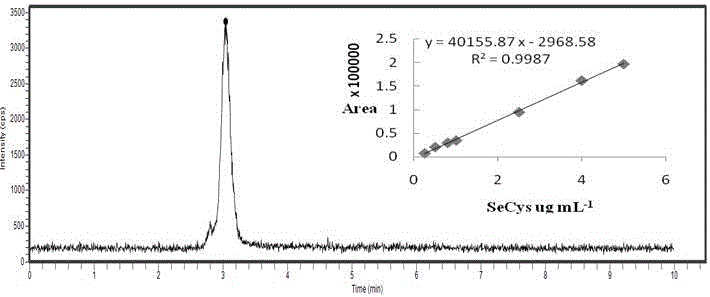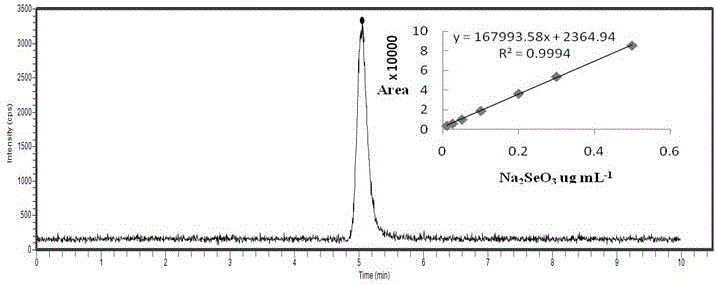Morphological analysis method for selenium in selenium-rich protein polysaccharide
A technology for seleno-enriched protein and speciation analysis, which is applied to the analysis of materials, material separation, measurement devices, etc., can solve the problems of not being able to meet the needs of rapid detection, and achieve the effects of environmental protection, low efficiency, and high recovery rate
- Summary
- Abstract
- Description
- Claims
- Application Information
AI Technical Summary
Problems solved by technology
Method used
Image
Examples
Embodiment 1
[0025] Embodiment 1 The drawing of standard curve
[0026] Accurately weigh 20.0 mg of SeCys2, add it into water containing dilute acid to make a 200 ug / mL standard stock solution, and then gradually dilute to 0.50, 0.30, 0.20, 0.10 and 0.05 ug / mL SeCys2 standard working solution. Accurately weigh 20.0 mg of SeCys, add it into water containing dilute acid to make a 200 ug / mL standard stock solution, and then gradually dilute it into 5.0, 4.0, 2.5, 1.0, 0.8, and 0.5 ug / mL SeCys standard working solutions. Accurately weigh 25.0 mg Na 2 SeO 3 Dissolve in water to make 100ug / mL Na 2 SeO 3 Standard stock solution, then gradually diluted to 0.50, 0.30, 0.20, 0.05 and 0.025 ug / mLNa 2 SeO 3 Standard working solution. According to the conditions in Table 1, apply HPLC-IPC-MS analysis to make a standard curve.
[0027]
Embodiment 2
[0028] Example 2 SeCys2, SeCys and Na 2 SeO 3 Assay
[0029] Accurately weigh 5 portions of 25 mg selenium-enriched proteoglycans into a 5 mL centrifuge tube, add 3 mg XIV protease, and then add 3 mL of water, sonicate at 37°C for 30 min, then centrifuge for 30 min at 10,000 rpm / min , collected the supernatant, and filtered it through a 0.45 μm aqueous phase filter membrane, and then applied HPLC-ICP-MS to analyze the selenium compounds in the enzymatic hydrolysis supernatant: SeCys2, SeCys and Na 2 SeO 3 Analyze and calculate SeCys2, SeCys and Na respectively according to the standard curve 2 SeO 3 content.
Embodiment 3
[0030] SeCys2, SeCys and Na in embodiment 3 selenoproteoglycan 2 SeO 3 Determination of the recovery rate of
[0031] Accurately weigh 3 parts of 25 mg selenoproteoglycan into a 5 mL centrifuge tube, add 3 mg XIV protease, and then add 1.5 mL of 0.30 ug / mL SeCys2, 8.0 ug / mL SeCys and 0.50 ug / mL SeCys2 Na 2 SeO 3 and supplemented with water to 3 mL, ultrasonicated at 37°C for 30 min, then centrifuged for 30 min at a speed of 10,000 rpm / min, collected the supernatant, and applied HPLC-ICP-MS to enzymatically hydrolyze the selenium compounds in the supernatant: SeCys2, SeCys and Na 2 SeO 3Analyze and calculate SeCys2, SeCys and Na respectively according to the standard curve 2 SeO 3 The content of, in conjunction with embodiment 2, calculate SeCys2, SeCys and Na 2 SeO 3 recovery rate.
[0032] According to the result and discussion that above embodiment 1-3 obtains:
[0033] 1. Drawing of standard curve
[0034] For SeCys2, SeCys and Na 2 SeO 3 To make a standard cu...
PUM
 Login to View More
Login to View More Abstract
Description
Claims
Application Information
 Login to View More
Login to View More - R&D
- Intellectual Property
- Life Sciences
- Materials
- Tech Scout
- Unparalleled Data Quality
- Higher Quality Content
- 60% Fewer Hallucinations
Browse by: Latest US Patents, China's latest patents, Technical Efficacy Thesaurus, Application Domain, Technology Topic, Popular Technical Reports.
© 2025 PatSnap. All rights reserved.Legal|Privacy policy|Modern Slavery Act Transparency Statement|Sitemap|About US| Contact US: help@patsnap.com



